The Relationship Between the Helper and Dog in the Initial Stages of the Bark & Hold
The purpose of this article is not to teach the finer points or small training steps for the Bark and Hold (BH), but rather to help people understand the concept of how this exercise evolves. If you don't enter this work with a clear understanding of which road to take, you will get lost.
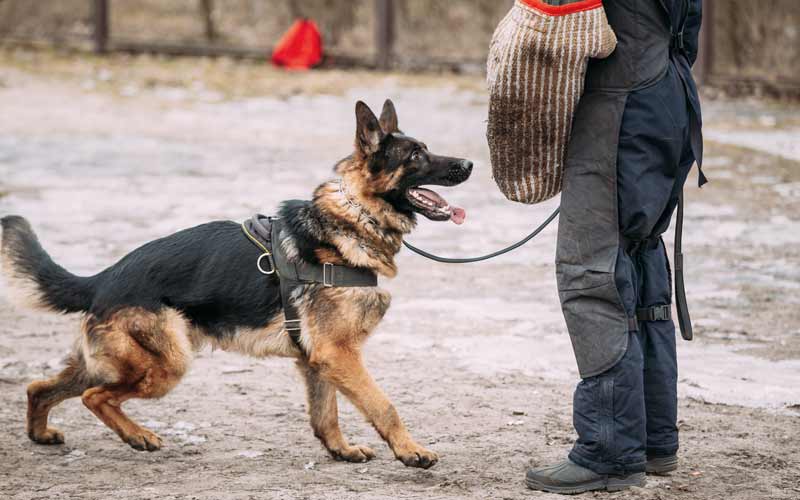
New trainers in the sport of Schutzhund or service dogs often misunderstand the concept of BH training. The correct BH is developed as an adversarial relationship between the helper and the dog. It is not developed in prey drive where the dog is trained to bark for its prey, although this is certainly a viable way of training dogs that lack the nerve to do it properly.
Let's take a second to talk about prey BH. A dog that barks in prey creates a picture of a dog that comes to the helper and barks in a controlled high- or normal-pitched bark. The image the dog presents lacks intensity. It is not the picture of a dog creating a serious threat. Sometimes, (but not always) the dog will actually be looking at and barking at equipment and not the man. Today's Schutzhund judges expect to see a strong serious defensive bark in the dogs. They easily recognize a prey bark for what it is, which is either a dog that lacks nerves or a dog that was poorly trained.
Before a dog can be started in BH training, it must go through prey bite development. If you have questions on the drives I am talking about, refer to my article titled Can I Train My Own Dog in Bite Work? and Understanding Drives. If you are unsure of how to take a dog through these initial stages of bite work that lead up to this training refer to my DVD titled, The First Steps of Bite Training.
In prey bite development, we teach a puppy to bark for his bite. From very early on the pup learns that barking makes the helper do something. It may make the helper look away in a submissive manner, it may make the helper back up, it may make him run a few steps and stop, it may even make him run past close enough so that the pup or young dog can get a bite. The young dogs will even learn that barking will make the helper run away so they can be sent off-leash to chase and bite the fleeing helper. The important thing for handlers to understand is that all of these things are done in prey drive.
The true BH is not started in bite development, it's started when the dog is a little more mature and ready for some defensive work.
When I explain how the process works, I always like to use a puppy and a cat as an example of what we are trying to accomplish. I was lucky enough to get some photos this week of my son's pup chasing and cornering our family cat. I will use these photos to help illustrate my points.
When a pup chases a cat it is doing so through prey drive, as the cat runs the prey is stimulated and the pup chases. When the cat has had enough of the game it will stop, turn get its hair up on its back (to make it look bigger and stronger than it actually is), and then "HISSSS" at the pup. It may even bat his paw at the pup's nose.
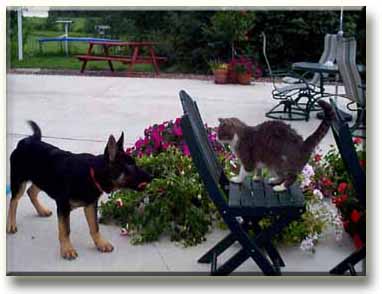
When this happens, every pup is going to slam on the brakes and back off. Initially, for a few seconds, the pup is startled and confused. Its prey item has turned into the aggressor and he is unsure of himself. The pup may get its hair up just like the cat.
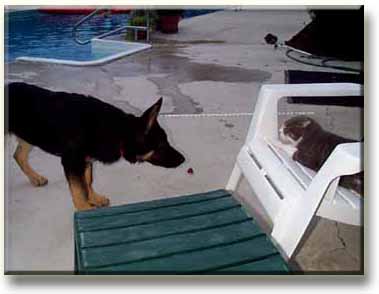
When the pup sees that he is not going to be attacked it will start to bark. The bark is not the same bark as the one used when it wants out of the pen or when it's barking for its ball, or even when it barks for its puppy tug. It's a deeper more serious bark. This is its defensive bark. In the best scenario, the bark will stimulate the cat to run and the chase will be on again.
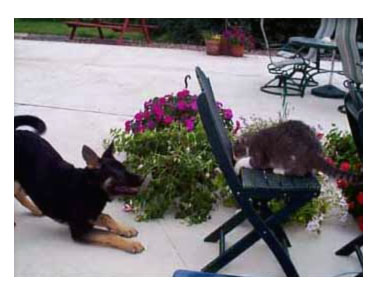
We use the same technique with young dogs over 1 year to develop a bark in the blind. The helper stimulates the dog and runs towards the blind. The handler releases his dog who then chases in prey drive. As the helper steps into the blind, he turns and puffs himself up in a threatening manner (like the cat). As the dog rounds the blind, he does not find the helper acting like a prey item but rather he finds himself facing someone who is squared off, ready for a fight, staring straight into his eyes.
This is the moment of training for the dog. It happens in a split second. We want a dog to switch drives from prey to defense. We will see the dog back off a few steps and bark with a more serious bark. When the dog decides to bark, it is critical that at that instant it is immediately rewarded with the helper trying to flee in prey with the dog chasing and getting a non-threatening prey bite.

It's also very important that when this moment of insecurity happens, the handler remains quiet and away from his dog. This work is between the helper and dog and has nothing to do with the handler. If there is a problem here, it's not up to the handler to step in and give his dog confidence by praising his dog. The solution either comes from the dog or the training must be backed up and the dog must go back into confidence-building exercises in prey drive work (i.e., more off-leash chases, etc.)
Just as importantly, it is a mistake for new helpers to stay in the blind and expect the dog to bark and bark for an extended period of time. The key to this training step is to immediately react to the change of drives and the first bark. Timings are critical. One or two barks and the helper pops out and tries to flee AWAY FROM THE YOUNG DOG.
The first stages of this work require some decisions being made concerning the level of maturity and level of prey drive development in the young dogs. The dogs must be mature enough to handle the stress of defensive work. While some dogs with good working genes and a sound foundation in prey development can handle the stress of early defense work at 12 months, others may have to wait until 18 to 24 months. Some German show lines and all-American bloodline dogs can never handle it.
At the beginning of this training, almost every young dog will back off and act a little insecure. If a dog does this, the helper must watch carefully and have patience. On the first attempt, if the dog backs off and takes a few seconds to survey the situation, the helper waits a few moments (maintaining eye contact with the dog). The wrong move at this moment can throw the young dogs into avoidance and they will run. The good dogs are going to bark immediately or stand and bark after a few seconds.
Should the dog turn and run, he is obviously ahead of himself in training. He needs more confidence, which is added through prey drive work.
During this work, the handler will notice the bark is a deeper more serious bark. Some dogs will get their hackles up while others may not. This is not important at this stage of training.
Initially, the helper rewards the shift in drives with a prey bite. As the dog gains confidence, experience, and maturity, the bites will switch from a prey bite to an occasion bite where the dog is driven and threatened with stick hits as you see in the photo below.
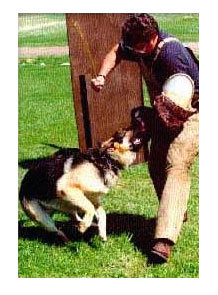
If done properly, this exercise is one of the first where we will begin to find out how strong our dogs really are.
I am often asked about the role of helper corrections in this work, especially by new K9 handlers who don't think that the helper should ever correct a dog. While this topic is the subject of another training article, understanding the adversarial role of the helper and dog lets new handlers have a better idea of the training concepts behind this work. In other words, a police service dog must have a healthy respect for a felony suspect on the street. There are clearly defined rules for when he can and cannot engage (bite) the suspect (the same is true in the sport of Schutzhund). The helper and the handler enforce these rules. A passive helper that is of no threat to a mature dog is always going to produce a very boring bark and a dirty dog (one that bites rather than barks).
Throughout this article, I have talked about proper bite development leading up to the BH. This is accomplished by taking the dog through several training steps. If you would like to learn more about this process you can refer to my video titled The First Steps of Bite Training and the really young pups can be worked with the information in The Foundation of Puppy Bitework.
If you find this article interesting and would like to read additional information on more advanced Bark and Hold Training for police service dogs, check out this article on my website: Training the Police Bark Hold by Kevin Sheldahl. Kevin is a good friend of mine. He is in 5 or 6 of my police training videos and is a full-time Police K9 handler in addition to a Judge for police dog competitions.




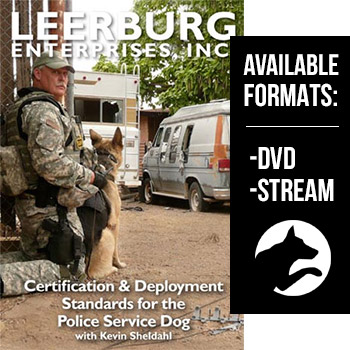

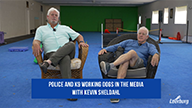


Ask Cindy.